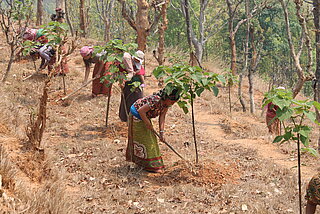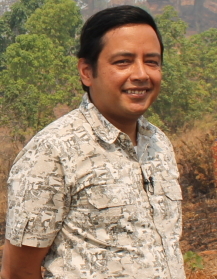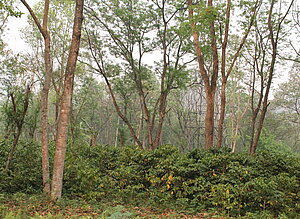Conservation of the Himalayan forests

In an interview, Dr Bhaskar Singh Karky talks about his work for the conservation of forests in the Himalayas.
Climate change is clearly visible in the Himalayan region. The glaciers in the highest mountains on earth have become smaller in the past decades due to rising temperatures. At the same time, the region has great potential to contribute to climate protection: the extensive forests serve as natural carbon sinks. The International Climate Initiative (IKI) has been promoting the conservation and restoration of forest ecosystems in Nepal, Bhutan, India and Myanmar since 2013. This is not only a contribution to climate protection, but also supports sustainable income opportunities for local communities and secures the habitat of endangered species such as the Asian elephant or the red panda. Dr Bhaskar Singh Karky coordinates the IKI project "Conservation of natural carbon sinks in the Himalayas". In an interview, he gives an insight into the project work on site.
How does the project work?
Bhaskar Singh Karky: ICIMOD is an intergovernmental organization based in Kathmandu. REDD+ Himalaya programme is implemented to assist the Himalayan countries prepare for REDD+. The main objective is to develop a socially inclusive and environmentally sound REDD+ framework adapted to the Himalayan context. ICIMOD coordinated the programme with REDD+ focal points of the four countries with GIZ providing the technical support.
The project works closely with the local people. What are the reasons why local communities are committed to forest conservation?
In this part of the world, a large portion of the population is dependent on biomass based subsistence economy. Almost more than 70% of the household energy requirements are met from fuelwood. There is a thin balance between sustainability and depletion of forest resources and the local communities know this very well. Forest conservation leads to sustainable supply of ecosystem services. But oftentimes, natural calamity, economic recession, corruption, political instability and violence, leads to depletion of this resource. In any forest, the situation is very dynamic and conversions can take place rapidly, so the communities remain vigilant on protecting their green asset. This is evident from the active participation of villagers in the forest committee meetings in India and Nepal.
What actually is a forest inventory and what are its goals?
 Forest inventory is a scientific way of estimating the availability of forest resources including carbon. This information needs periodical updates to inform the managers of the state of the forest. It allows estimating the growth of timber and calculating the allowable annual cut limit so that the forest is managed in a sustainable manner.
Forest inventory is a scientific way of estimating the availability of forest resources including carbon. This information needs periodical updates to inform the managers of the state of the forest. It allows estimating the growth of timber and calculating the allowable annual cut limit so that the forest is managed in a sustainable manner.
Forest inventory also quantifies the emission reduction capacity of forests. Supported by REDD+ Himalaya, Bhutan has completed the forest and carbon inventory at national scale thereby generating scientific data supporting its carbon neutral development trajectory.
How does the IKI support the partner countries in practice?
The IKI supports partner countries in conducting forest inventories, developing management plans and the consideration of forests as carbon sinks in national policies and legislation. Strengthening community-based organizations in Myanmar was one example for contributing towards development of a framework within which communities and community forest owners can claim their right to manage forests in a way that secures their livelihood.
In Nepal, improving forest management through the cooperatives that manage the community forests, the project helps to improve knowledge and enable utilization. Best practices that emerge from working with a few community forest user groups gets scaled relatively quickly through the federation i.e. Federation of Community Forest Users Nepal. The REDD+ Action Plan manual developed by this project and adopted in multiple countries is another best practice.

As carbon sinks, intact forests contribute to climate protection and are habitats to a diversity of species. How does the project work in the protection of biodiversity?
The IKI project has developed a Biodiversity Monitoring Protocol for REDD+ to ensure the environmental integrity of any REDD+ interventions. Numerous trainings were conducted so that this protocol can be applied in specific REDD+ landscapes. The protocol can be customized to suite the different country’s context. The project also conducted studies on human wildlife conflict in one of the district where this was a major challenge to REDD+. Through the experience of this IKI project, new insight are developed into how river-forest corridors or riverscapes can be integrated into REDD+ architecture so that terrestrial and aquatic biodiversity also benefit. This is the new approach ICIMOD has been taking to add value to REDD+.
What lessons can be learned from project work in the Himalayan region - also for other countries?
With modernisation, better education, mobile connectivity and migration, the rural mountain population has altered the way they view their forests. This IKI project builds on this transformative perspective, which views forests as a green asset with multiple ecosystem services to be harnessed by local communities when safeguarded by devolved policy and regulations. This has renewed faith in conservation at the grassroots level. These local institutions as social capital must be leveraged for linking local conservation efforts with climate finance under the Paris Agreement. The future lies in article 6 that allows for global cooperation for higher ambition mitigation and adaptation actions and to promote sustainable development and environmental integrity through actions of public, private and community working together.
The link has been copied to the clipboard
Contact
IKI Office
Zukunft – Umwelt – Gesellschaft (ZUG) gGmbH
Stresemannstraße 69-71
10963 Berlin


